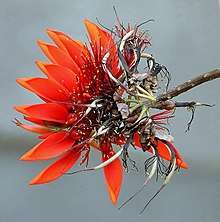Erythrina variegata
Erythrina variegata, commonly known as tiger's claw or Indian coral tree,[2] is a species of Erythrina native to the tropical and subtropical regions of eastern Africa, the Indian Subcontinent, northern Australia, and the islands of the Indian Ocean and the western Pacific Ocean east to Fiji.[2]
| Tiger's claw | |
|---|---|
 | |
| Tree in Kolkata, West Bengal, India. | |
| Scientific classification | |
| Kingdom: | Plantae |
| Clade: | Tracheophytes |
| Clade: | Angiosperms |
| Clade: | Eudicots |
| Clade: | Rosids |
| Order: | Fabales |
| Family: | Fabaceae |
| Genus: | Erythrina |
| Species: | E. variegata |
| Binomial name | |
| Erythrina variegata | |
Description

E. variegata is a thorny deciduous tree growing to 27 m (89 ft) tall. The leaves are pinnate with a 20 cm (7.9 in) petiole and three leaflets, each leaflet up to 20 cm (7.9 in) long and broad. It has dense clusters of scarlet or crimson flowers and black seeds.[3]
Uses
Erythrina variegata is valued as an ornamental tree. Several cultivars have been selected, including 'Alba' with white flowers.[3]
In Vietnam, the leaves are used to wrap fermented meat (Vietnamese: nem).
E. variegata is known as dapdap in the Philippines where its bark and leaves are used in alternative medicine.[4] In Siddha medicine, it is used especially for menstrual disorders and fissures at penis tip (Tamil: ஆண்குறிப்புண்).
E. variegata is often used in agroforestry systems. It can be used for fodder as its foliage has a good nutritive value for most livestock.[5]
The seeds are poisonous in their raw state, but can be cooked and eaten. Along with the bark, the seeds were used to stupefy fish, making them easier to catch.[6]
The Formosan aboriginal tribe, the Puyuma carve a mortar called a ta?ur from the trunk of the tree. It is used for pounding sticky rice that is later to be steamed.
Cultural impact

E. variegata was designated the official flower of Okinawa Prefecture in 1967. The deigo flower features in the popular song "Shima Uta" by The Boom, one of the most well-known songs associated with Okinawa. In addition, the use of the wood of the deigo tree is one of the unique characteristics of Ryukyuan lacquerware.
In Sri Lanka, the blossoming flowers of the tree are associated with the advent of the Sri Lankan (April) New Year. The plant is known as Erabadu (Sinhala: එරබදු) in Sinhalese.
References
- Groom, A. (2012). "Erythrina variegata". IUCN Red List of Threatened Species. 2012: e.T19891448A20072331. Retrieved 20 March 2020.
- "Erythrina variegata, Erythrina variegata". Germplasm Resources Information Network (GRIN). Agricultural Research Service (ARS), United States Department of Agriculture (USDA). Retrieved 18 December 2017.
- Huxley, A., ed. (1992). New RHS Dictionary of Gardening. Macmillan. ISBN 0-333-47494-5.
- "Dapdap / Erythrina variegata / Indian coral tree: Philippine Medicinal Herbs / Philippine Alternative Medicine". www.stuartxchange.org. Retrieved 2017-03-10.
- Heuzé V., Thiollet H., Tran G., Edouard N., Lebas F., 2018. Coral tree (Erythrina variegata). Feedipedia, a programme by INRA, CIRAD, AFZ and FAO. https://www.feedipedia.org/node/23080
- Hargreaves, Dorothy; Hargreaves, Bob (1970). Tropical Trees of the Pacific. Kailua, Hawaii: Hargreaves. p. 24.
External links

- Elevitch, Craig R.; W. Arthur Whistler (April 2006). "Erythrina variegata (coral tree)" (PDF). The Traditional Tree Initiative. Cite journal requires
|journal=(help) - Flowers of India - Indian Coral Tree
